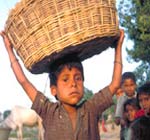
May 22: Child labour is a menace which threatens the future of this society. Its predominance in the society over other problems can be felt by the child work participation rates which are higher in Indian than in any other developing country.
A study conducted by the ILO Bureau of Statistics found that "Children’s work was considered essential to maintaining the economic level of households, either in the form of work for wages, of help in household enterprises or of household chores in order to free adult household members for economic activity elsewhere" (Mehra-Kerpelman 1996, 98).
Child labour is the primary source of income for poor families. In some cases, the study found that a child’s income accounted for between 34 and 37 percent of the total household income. This study concludes that the child’s income is important to the livelihood of a poor family. There is a questionable aspect of this study. A survey was conducted, and the responses given by the parents of child labourers were stratling. Parents would be biased into being compelled to support their decision to send their children to work, and said that it was essential for the toddlers to work. They may be probably right: for most poor families in India, alternative sources of income are almost non-existent. There are no social welfare systems such as those in the European countries, nor is there any easy access to loans or grants.
The major factor responsible for child labour is poverty. Even though children are paid less than adults, whatever incomes they earn benefit the poor families and sometimes to an extent that the family will perish without them. In addition to poverty, the lack of adequate and accessible sources of credit, forces these poor parents to engage their children in harsher forms of child labour -- bonded child labour.
Some parents also feel that a formal education is not of any help, and that children gain skills through labour at a young age. Such narrow views do not take the long term developmental benefits of education into account. Another determining factor is the access to education. In some areas, education is not affordable, or is inadequate. Without any alternatives, the children are pushed to spend their time working.
A prominent indicator of child labour is low literacy level and high dropout rates in the most vulnerable parts of India. The educational system is required to be made more accessible for those vulnerable sections of the society. However poverty also plays a role in the ineffectiveness of the educational system. Dropout rates are high because children are forced to work in order to support their families.
The attitudes of the people also contribute to the lack of enrollment – parents, in such cases parents hardly understand or wait for the greater good, but instead feel that work develops skills that can be used to earn an income, while education does not help in this matter. Compulsory education may to deal with this attitude. Sri Lanka and Kerala are good examples which show that compulsory education has worked in those areas.
Child labour cannot be eliminated by focusing on one determinant, for example education, or by mere enforcement of child labour laws. The government of India must ensure that the needs of the poor are filled before waging a war against child labour. If poverty is addressed, the need for child labour will automatically diminish. No matter how hard the government tries, child labour will continue to persist until the need for it is removed.
The development of India as a nation is being hampered by child labour. Children are growing up illiterate because they have been working and not just attending the school. A cycle of poverty is formed and the need for child labour is reborn after every generation.
The government of India has implemented the Child Labour Act in 1986 that forbids child labour in certain areas and sets the minimum age of employment at fourteen. This Act fall short of making all child labour illegal, and fails to meet the ILO guideline concerning the minimum age of employment which is set at fifteen years.
Though policies are in place that could potentially reduce the incidence of child labour, enforcement is a problem. India needs to address the situation by tackling the underlying causes of child labour through governmental policies and the enforcement of these policies. Only then will India succeed in the fight against child labour.
If child labour is to be eradicated in India, the government and those responsible for enforcement need to start doing their jobs with a bit commitment. Policies can and will be developed concerning child labour, but without enforcement they are all useless.
|
|


Comments: